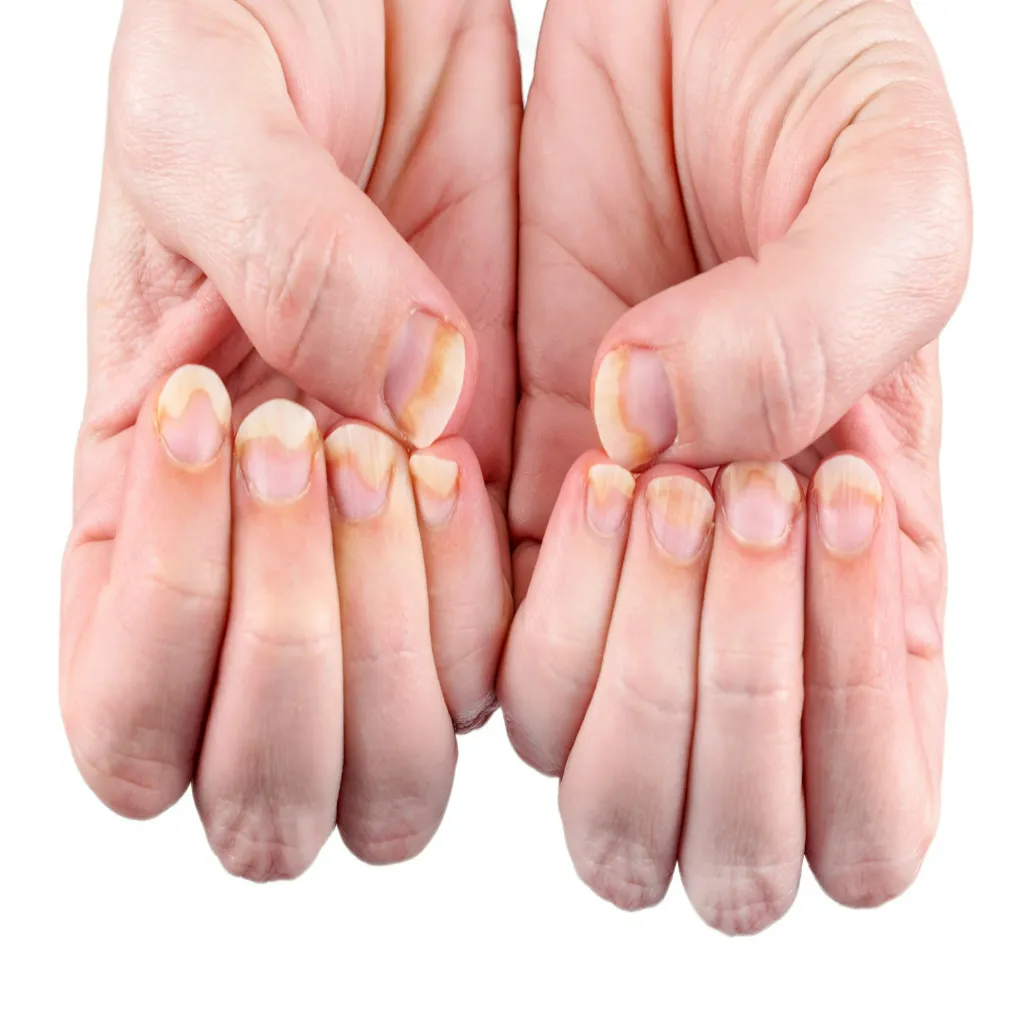Nails support and protect the sensitive tips of our fingers and toes. Common causes of nail problems include injury, infection, and skin diseases such as eczema and psoriasis. Healthy nails appear smooth and have consistent coloring. As you age, you may develop vertical ridges, or your nails may be a bit more brittle. This is harmless. Spots due to injury should grow out with the nail.
Nail Abnormalities such as spots, discoloration, and nail separation can result from injuries to the fingers and hands, viral warts, infections, and some medications, such as those used for chemotherapy.
Certain medical conditions can also change the appearance of your fingernails. However, these changes can be difficult to interpret. Your fingernails’ appearance alone isn’t enough to diagnose a specific illness. A doctor will use this information, along with your other symptoms and a physical exam, to make a diagnosis.
You should always consult your doctor if you have any questions about changes in your nails.
Fingernail Abnormalities
Some changes in your nails are due to medical conditions that need attention. See your doctor if you have any of these symptoms:
- Discoloration (dark streaks, white streaks, or changes in nail color)
- Changes in nail shape (curling or clubbing)
- Changes in nail thickness (thickening or thinning)
- Nails that become brittle
- Nails that are pitted
- Bleeding around nails
- Swelling or redness around nails
- Pain around nails
- Nail separating from the skin
Diagnosis and treatment of nail problems
Any abnormal changes to your nails should be medically investigated. See your doctor for treatment or possible referral to a dermatologist. If the cause of your nail problem is not immediately apparent, your doctor may take nail clippings and scrapings from beneath the nail for laboratory analysis. Fingernail infections usually respond faster to treatment than toenail infections.
Depending on the cause, treatment may include:
- Antibiotics for bacterial infections
- Antifungal preparations, mainly oral tablets, for fungal infections in the nails
- Treatment for any contributing skin disease
- Advice on appropriate nail care.
These nail changes can be caused by a variety of different conditions, including the ones we describe below.
Beau’s lines
Depressions that run across your fingernail are called Beau’s lines. These can be a sign of malnourishment. Other conditions that cause Beau’s lines are:
- Diseases that cause a high fever such as measles, mumps, and scarlet fever
- Peripheral vascular disease
- Pneumonia
- Uncontrolled diabetes
- Zinc deficiency
Nail Clubbing
Clubbing is when your nails thicken and curve around your fingertips, a process that generally takes years. This can be the result of low oxygen in the blood and is associated with:
- Cardiovascular diseases
- Inflammatory bowel disease
- Liver diseases
- Pulmonary diseases
Nail Koilonychia (spooning)
Koilonychia is when your fingernails have raised ridges and scoop outward, like spoons. It’s also called “spooning.” Sometimes the nail is curved enough to hold a drop of liquid. Spooning can be a sign that you have:
- Iron deficiency anemia
- Heart disease
- Hemochromatosis, a liver disorder that causes too much iron to be absorbed from food
- Lupus erythematosus, an autoimmune disorder that causes inflammation
- Hypothyroidism
- Raynaud’s disease, a condition that limits your blood circulation
Nail Leukonychia (white spots)
Nonuniform white spots or lines on the nail are called leukonychia. They’re usually the result of a minor trauma and are harmless in healthy individuals. Sometimes leukonychia is associated with poor health or nutritional deficiencies. Factors can include infectious, metabolic, or systemic diseases as well as certain drugs.
Nail Mees’ lines
Mees’ lines are transverse white lines. This can be a sign of arsenic poisoning. If you have this symptom, your doctor will take hair or tissue samples to check for arsenic in your body.
Nail Onycholysis
When the nail plate separates from the nail bed, it causes a white discoloration. This is called onycholysis. This can be due to infection, trauma, or products used on the nails.
Other causes for onycholysis include:
- Psoriasis
- Thyroid disease
Pitting Nails
Pitting refers to small depressions, or little pits, in the nail. It’s common in people who have psoriasis, a skin condition that causes the skin to be dry, red, and irritated. Some systemic diseases can also cause pitting.
Terry’s nails
When the tip of each nail has a dark band, it’s called Terry’s nails. This is often due to aging, but it can also be caused by:
- Congestive heart failure
- Diabetes
- Liver disease
Yellow nail syndrome
Yellow nail syndrome is when the nails get thicker and don’t grow as fast as normal. Sometimes the nail lacks a cuticle and may even pull away from the nail bed. This can be the result of:
- Internal malignancies
- Lymphedema, swelling of the hands
- Pleural effusions, fluid buildup between the lungs and chest cavity
- Respiratory illnesses such as chronic bronchitis or sinusitis
- Rheumatoid arthritis
These are just some of the signs of abnormal fingernails. Having any of these signs isn’t proof of any medical condition. You’ll need to visit your doctor to determine if your condition is serious. In many cases, proper care of your nails is enough to correct their appearance.
Self-help strategies for healthy nails
- Ways to reduce the risk of nail problems include:
- Practice good personal hygiene.
- Wear protective gloves for wet jobs such as washing the dishes.
- Avoid harsh chemicals such as strong soaps and detergents.
- Avoid or limit the handling of chemicals such as hair dyes.
- Take care with the use of nail polish.
- Don’t clean under your nails too often or too aggressively.
- When giving yourself a home manicure, do not push back the cuticles.
- Resist the urge to bite or tear off hangnails – use nail clippers.
- Don’t bite your nails.
- Remove artificial nails carefully and according to the manufacturer’s instructions.
- Don’t smoke.
- Moisturize your hands frequently, particularly after washing them.
- Remember to rub the moisturizer over your nails and cuticles too.
- Treat any sign of eczema on your hands promptly.
- To protect yourself from fungal infections, don’t share towels, always dry yourself thoroughly after bathing (particularly between the toes), and wear thongs in communal bathing areas such as the local gym or swimming pool.
- Make sure your shoes are well-fitting and have plenty of room for air movement.
Disclaimer
Please seek professional help regarding any health conditions or concerns. This article is for information purposes only and should not be considered a substitute for medical expertise. These are opinions from a panel of individual experts and are not to be considered opinions of Medikstar.

